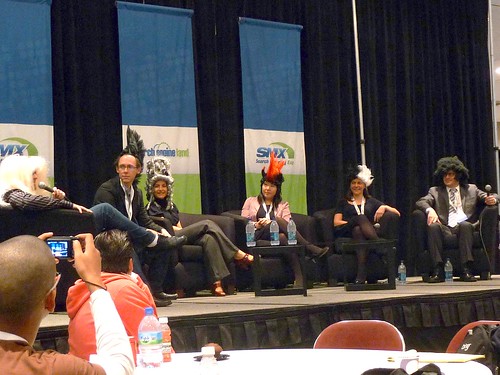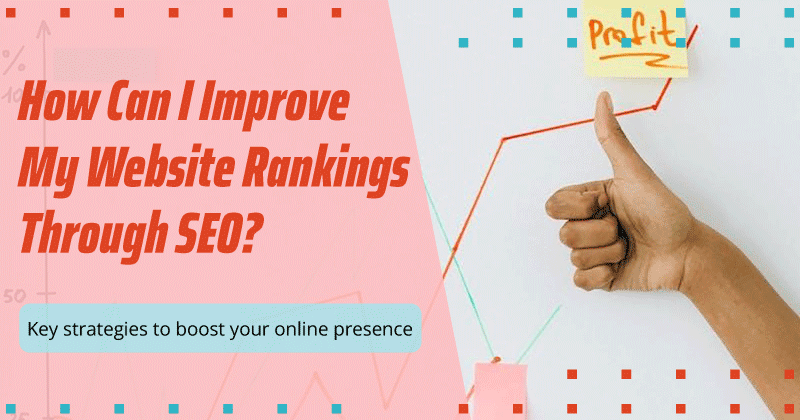Keynote: What’s Next in Search: The Bigwig Crystal Ball Panel
Good morning and welcome to day 2 of SMX East! Pop quiz time! But don’t worry, it’s multiple choice — should be easy. Virginia Nussey A) had a blast at IM Charity Party last night, B) forgot to bring extra laptop batteries to the conference and isn’t afraid to fight you for a seat next to the power outlet, or C) is stoked to see the future of search in this crystal ball of a power panel.
Trick question! It’s D, all of the above!
Chris Sherman is on the stage and is wearing a rainbow clown wig. And out struts our panelists, also donning crazy wigs. They took this big wig thing very seriously! Here’s the line up:
Greg Boser, President and CEO, 3 Dog Media
Andrew Goodman, Founder and Principal, Page Zero Media
Sara Holoubek, Consultant, Columnist and SEMPO Board of Directors,
Jack Menzel, Group Product Manager, Google
Kristine Segrist, Search Managing Director of MEC Interaction, GroupM Search
Julie Sun, Director, Digital Marketing, MTV

Let’s start at the beginning. Where’s the search industry today?
Sara: We’re seeing budgets shrinking, but money is moving online. There’s positive movement, but we’re still feeling the pain.
Julie: There’s a lot of interest in digital and search. The budgets are tighter but digital is still able to maintain a foothold.
Greg: The amount of time it takes to negotiate and close a deal is dramatically longer. Price has dropped as far as what you can charge, but getting to the “ink” is dramatically longer. It’s not like ’06, where people came to you with buckets of cash. I think we’re starting to see a bounce back, though.
Jack: Through the recession we’ve seen consistent growth and people are searching more than they were a year ago.
Andrew: Google’s found ways to grow in ways that other companies never would have, but if you look at the competition for placement among some sectors, those won’t bounce back the same way.
Chris: Is there even “traditional” media anymore? What kinds of needs do you see larger brands having?
Sara: Ad formats are antiquated concepts. What we’re seeing is morphing. Media is communication. Companies don’t have TV or print spend, and our space is less expensive than some of those traditional formats.
Kristine: Every dollar is more accountable, regardless of channel. There’s less appetite for testing, to some degree. Content delivery has to be agnostic — don’t be married to how it’s delivered, as long as you’re increasing views of your content.
Julie: Traditional marketing isn’t going away. What we’re doing at MTV is trying to complement them. A message on TV matches the message online, and we see a lot more effectiveness and engagement when channels complement each other. So one can’t exist without the other. From a budget standpoint, we can’t stop both traditional and online marketing because they work together.
Greg: In the future we’re going to see traditional media as a way to promote online, interactive content. There’s a whole middle tier of companies that are finding bang for the buck by using traditional channels to promote their Twitter account, for example.
Chris: Is Twitter a flash in the plan? Any thoughts of social media’s place going forward?
Kristine: Search and social inform each other. Search insights can help us understand what we should be listening to in the first place. The insights you glean from social monitoring can be activated quickly in search. If you know there’s an issue or you want to capitalize on a trend, you can leverage search quickly.
Andrew: The signals we had in organic were getting stale. Social is a fertile new ground.
Jack: Social is creating more information and connections that Google is excited about serving to people.
Sara: One: Media has always been social. It’s not new — we’re just freaked out because we can see it. And two: search and social are totally malleable. They can be used for direct response, awareness, as listening devices… it’s hard for a CMO or COO to see where it fits in the company. We need to do a better job explaining what it is and how we can use it.
Greg: Twitter has changed the landscape. It’s so quick and easy and there are so many ways it can be used. You don’t have to be Zappos and have hundreds of thousands of followers. Organic search has become more the space of the big players, but Twitter allows businesses to gain some traction before they show up in search.
Chris: With more narrow and precise targeting options, we’re starting to see some backlash. A study from UC Berkley found that more than 60 percent of participants felt that targeted ads weren’t okay. Are we going to be able to take advantage of these sophisticated technologies?
Andrew: The primary blind spot we have in North America is relatively lenient privacy legislation. It will probably be clamped down more in the future. But at the same time, targeted ads perform better than other contextual channels.
Kristine: The major scrutiny of privacy issues are in reaction to display ads. It’ll be interesting to see how we can leverage search behavior in offline forms.
Jack: Personalization feels less creepy when Google gives you exactly what you asked for in the first place. Also, giving users control over what info we can use in targeting, transparency, makes people more comfortable.
Greg: Time to pick on Google. Transparency is a bit of a crock. There’s a 30-minute cookie. I’m not a logged in user, but I still get local results for Beverly Hills. I’m not in Beverly Hills — maybe my ISP is or something. But my only alternative is to tell Google where I am. And I don’t want to opt in to tell Google where I am.
Jack: If there’s a query with local intent we’re going to give you our best guess.
Greg: But Google is showing local results for broad queries. It’s assuming you know better than I do about what I’m looking for.
Sara: Isn’t it interesting that of all the ways you can reach customers, search is the most scrutinized. There are a lot of imperfect systems — marketers can buy your information, send things right to your house. Maybe we need to rebrand it as “tailored” advertising. No one wants to be a target. Though maybe the rise of Google is the reason we’re paying more attention and scrutinizing privacy. It’s a good check and balance that Greg and the government raises the issue. At the end of the day we should be aware of the trail of data we leave when we push a button or buy something.
Greg: Personalization is not you spying on me. Personalization is me telling you about my needs and my wants.
Chris: The emergence of Bing and Bing’s partnership with Yahoo are among the biggest changes in search. How’s having 2 players rather than 3 going to change our space?
Kristine: I think it’s appropriate that the DOJ looked at the deal. But I am a fan of the deal. It’ll be interesting to see how it’s going to play out for agencies. I think it’s going to be a good thing for agencies. It’s going to be a slow transition and nothing’s going to happen in the short term. I hope we’re able to merge the best of the best and not lose any of the good things.
Julie: It’s good from a budget, targeting and volume standpoint. It will make the job a little easier.
Andrew: Is anyone going to miss Panama when it’s gone? [No hands.] I’d like to see something that turns the whole game on its head. The common assumption is that you can’t beat Google. I’m not sure that’s true — these things sneak up on you.
Sara: 10 years ago we might have been rooting to put a dent into Microsoft, and a decade later, it’s now Google. I expect someone to come out of left field. While 2 might make our job easier, it might be good for a newcomer to be on the field in case the offerings get stale.
Chris: If we came back in 5 years, what would we be talking about?
Andrew: I like the idea of trust and peer networks helping you decide stuff. But having that integrated into our apps, for instance — something universal.
Kristine: All media forms will be addressable, and we’ll be looking at a much more complex view of attribution.
Julie: Things move so quickly. I’d say privacy is still going to be an issue. But as younger kids get older, they’re used to being more lax about privacy. It might take a turn. With search and online marketing, it’s going to be more like traditional.
Sara: I’m so excited for the keyboard to disappear and be replaced by voice activated technologies.
Jack: We’ll be talking about the same angst we have today — “I can’t find exactly what I want.” It’ll be faster and more accurate, but search is so big.
Greg: Technology stuff doesn’t usually pan out. We do eventually get there, but in the immediate future, the biggest thing is going to be the complete integration of data streams. The concept of Google Wave will be the future.

One Reply to “Keynote: What’s Next in Search: The Bigwig Crystal Ball Panel”
There is most definitely a change in online budgeting and how long it takes to close a contract.
Of course SEO doesn’t have to be local and I think the backward slide has lost a lot of its momentum. Those who can afford it are reorganizing now for whatever budget push they can manage for 2010, so I expect that anyone who hangs on in the thinning SEO herd will fare well enough come next season.
LEAVE A REPLY









